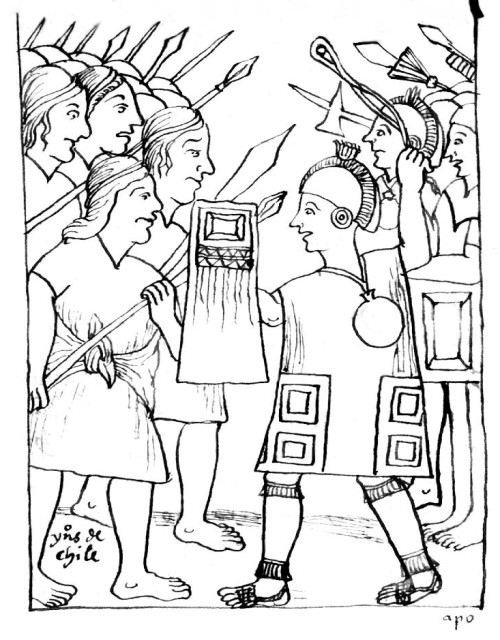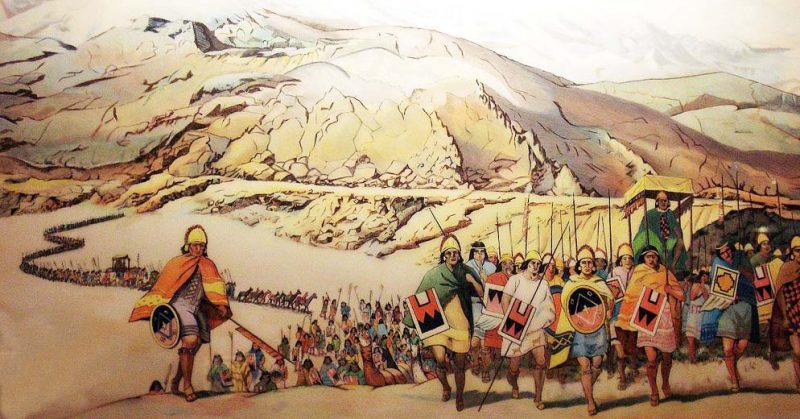In the early 16th century, the Incas were one of the most powerful nations in the Americas. The greatest military force for thousands of miles, they conquered all around them. Yet in November 1532, a force of less than 200 Spanish conquistadors seized control of their empire.
What was the Incan army like, that let it become such a mighty force, and yet left it vulnerable to this surprising fall?
Imperial Conquest
Incan warfare was a series of campaigns of conquest. Their organised and disciplined forces, backed up by an infrastructure network of farms, roads and government, allowed them to defeat and take control of smaller neighbours. When the conquistadors arrived, the Incas were ruled by Atahualpa, who five years earlier had been leading Incan warriors in the suppression of new northern territories.
This was as an ambitious, aggressive nation under arms. Like many other societies built on conquest, there was a clear distinction between the ruling minority – the Incas – who provided the officers leading the armies, and the majority population, a diverse range of recently conquered peoples, who made up the mass of the army.
Divine Leadership
The focus of Incan leadership, in war as in peace, was the divine leadership of the emperor, the supreme Inca. Like many historical nations, including those in Europe at the time, the Incas did not distinguish between divine and earthly power.
The connections between religious and political power ran deeper among the Incas than the Spanish. The conquistadors had a secular, though divinely appointed, ruler in the Spanish king, and a separate religious leader in the Pope. The emperor of the Incas combined these roles in one person. He was both the messenger of the gods and the head of the nation.
Peasant Conscripts
The Incan army was mostly made up of peasant conscripts forced into arms out of obligation to their rulers. They might accept the obligation to fight, some might even relish it, but many would not have wanted to be there.
An Infantry Army
It is usual for poor conscript armies to be made up mostly of hordes of infantry. But in Incan warfare, the armies were entirely made up of infantry, lacking both cavalry and artillery.
The absence of cavalry came down to the animals available to them. The only horses in the Americas were the ones European invaders brought, and these were so amazing to locals that the emperor’s guards ran from one in terror. There were no camels or elephants, other beasts which have occasionally been used in mounted warfare. The Incas had nothing to ride, and so no cavalry.
They also lacked artillery. Though capable of some amazing feats of engineering, these did not extend to ballistae, catapults, or other heavy missile weapons.
Communication for Speed, Not Detail
The Incan empire had an impressive communications network, given the resources available. Relay runners stationed around the country carried military intelligence at a remarkable speed for a society that had no mounts or long-distance signalling equipment.
There were no written records, the nearest equivalent being knotted strings called quipus. The information these could store was limited, making it hard to record and share detailed information, whether tactical manuals or details of enemy forces.
Bronze Age Equipment
Incan technology was at a level generally labelled as bronze age. The first usable deposits of iron ore were not discovered in the region until 1915, nearly 400 years after the fall of the Incas.
As a result, weapons and armour could not be made out of iron or steel. This prevented the Incas from making the sort of hardened equipment or sharp, enduring blades that had been prevalent in Europe and Asia for the previous two millennia, and which the conquistadors used.
Bludgeoning Brawlers
As a result, Incan troops were mostly armed with bludgeoning weapons. Most common were clubs, such as the heavy two-handed porra with its five or six pointed protrusions. Bladed battle-axes were used, but they were not sharp enough to sever a limb. There were lances with points of bronze, copper or sharpened wood. Nothing had the penetrating power of iron or steel weapons.
Incan combat was mostly about smashing rather than cutting, slicing or stabbing.
The Warak’a
Missiles were used in combat, including hand thrown darts tipped with bone or wood. The most deadly ranged weapon was a fibre sling called the warak’a, often made of wool. A stone the size of an egg was placed in the centre of the warak’a, which the user then whirled around his head. When released, the stone was propelled with enough force to crack open a human skull or snap a Spanish sword.

Cotton Armour
A few warriors wore what we now imagine as armour, in the form of breast or back plates made of copper. Most wore only cotton armour. The padded cloth could absorb the blows of bludgeoning weapons or the impact of a warak’a. It might even provide protection against the penetrating power of the edged and pointed weapons they faced in their wars of combat.
But when the conquistadors arrived, this armour proved no use at all. Sharp Spanish blades slashed through it. Arquebus bullets and crossbow quarrels punched holes in this protection, easily killing the men within.
Amazon Detachments
Much as the British would later use the Nepalese Gurkhas, the Incas made use of the special qualities of conquered peoples. Small groups from the Antisuyu, a section of Amazon jungle in the east of their empire, sometimes featured in their armies.
The Incas never penetrated far into the Amazon rainforest, which was dense, hard to navigate, and even harder to dominate. The troops they used from there brought something novel to the armies – bows and arrows. A different sort of long-range attack from the warak’a, these had the ability to penetrate cloth armour, though not the steel their new enemies wore.
